The results of the specialists’ and scientists’ researches. Рубрика в журнале - Nanotechnologies in Construction: A Scientific Internet-Journal
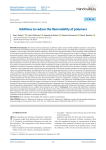
Additives to reduce the flammability of polymers
Статья научная
Introduction. This review article provides data on additives used to reduce the flammability of polymer compositions. It is shown that not individual substances are used for this purpose, but their mixtures, including flame retardants, synergists, and stabilizers. The principle of operation of flame retardants is that when the appropriate degree of concentration of flame retardants in the material is reached, they do not allow it to burn without the presence of an ignition source. Under the influence of fire on the processed material, various chemical and physical processes occur in it, preventing the flame from flaring up. Main part. The advantages and disadvantages of the main flame retardants currently used, which include antimony compounds, halogen-containing compounds, phosphorus-containing substances, as well as aluminum and magnesium hydroxides, are analyzed. Various mechanisms for slowing down combustion processes when flame retardants are used are considered. It has been shown that bromine-containing flame retardants are much more effective than chlorine-containing ones. They decompose in a narrow temperature range. In addition, plastics containing bromine compounds as flame retardants are easily recycled due to the high thermal stability of such flame retardants. Phosphorus-containing compounds have a plasticizing ability and increase the fire resistance of plastic compounds. The action in the condensed phase is that during the decomposition of the flame retardant, phosphoric acid residues are formed, which act as dehydrating agents, contributing to the formation of carbonized structures. In this case, an aerosol can also be formed, which contributes to the deactivation of radicals due to the wall effect. Of particular interest are compounds containing halogen and phosphorus. The advantages of these compounds are as follows: by splitting off halogen radicals during decomposition, they deactivate active radicals; contribute to the formation of carbonized structures. Metal hydroxides decompose under the influence of high temperatures with the release of water. The decomposition reaction is endothermic, resulting in cooling of the substrate to temperatures below the flash point. The formation of water contributes to the dilution of combustible gases released during decomposition, weakens the effect of oxygen and reduces the rate of combustion. The effectiveness of hydroxides is directly proportional to their content in the polymer. The greatest efficiency is observed when aluminum hydroxide is introduced into oxygencontaining polymers (polyethylene terephthalate, polybutylene terephthalate, polyamide). Magnesium hydroxide is more expensive than aluminum hydroxide, but has a higher heat resistance (up to 300оC). Conclusion. Thus, among the listed flame retardants, aluminum and magnesium hydroxides occupy the first place in terms of the volume of use (more than 40% of the total volume of flame retardants). This is due to their low cost, manufacturability of their application and environmental safety. A well-chosen metal hydroxide system produces a low-cost non-combustible material with little fumes from decomposition. Therefore, the use of metal hydroxides as flame retardants is constantly increasing.
Бесплатно
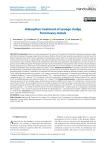
Adsorption treatment of sewage sludge from heavy metals
Статья научная
Introduction. Because of urban development the volume of municipal and industrial wastewater are growing. Along with them the amount of sewage sludge (SS) also increases. Millions of tons of SS are currently accumulated on the territory of the Russian Federation and contain various pollutants, including heavy metals (HM). In this regard, the search for effective methods of SS treatment from HM is an urgent problem. The main methods of SS treatment are drying, dehydration, thermal methods, UV and microwave wave treatment. These kinds of disinfection eliminates many pathogenic microorganisms, but they are quite expensive and not effective against HM. Reagent methods include SS disinfection with quicklime (CaO). However, decontamination requires large doses (up to 30%) and it is also ineffective against HM. Humic-mineral reagent are more effective, they are based on crushed caustobiolites, their cleaning capacity from HM is 19–87%. Methods and materials. The authors have previously shown the effectiveness of wastewater treatment from HM using sorbents based on dolomite, quartzite, and waste from mining and processing plants. Therefore, a method for SS treatment from HM using sorbents based on dolomite, humates, and CS containing CaCO3 and humic compounds was proposed. In this regard, a method was proposed for SS treatment from HM using three types of sorbents based on: 1) waste of thermal power plants (TPP) – conditioned sludge (CS) containing CaCO3 up to 68% and humic compounds up to 12% – sorbent 1 (S1); 2) dolomite – Mg and Ca carbonate in a composition with sodium humate (25%)– sorbent 2 (S2); 3) modified dolomite with sodium humate (1%) – sorbent 3 (S3). Results and discussion. In laboratory experiments, the cleaning capacity of SS was studied using a dolomite-based sorbent modified with humate (1%). In field tests, a decrease in the concentration of HM in SS was studied with the use of sorbents based on CS and the complex sorbent dolomite-humate (75:25). The cleaning capacity of SS from HM increases in the series: sorbents based on waste from TPP – CS containing CaCO3 and humates (cleaning capacity E = 4.8–48.6% for dried SS and 29.3–53.3% for dehydrated SS) < sorbent based on a composition of dolomite with humate (E = 65.1–92.1% for dried and 56.6–89.4% for dehydrated SS) < a dolomite-based sorbent modified with humate (E = 90.8–99.9%). Conclusions. The maximum cleaning capacity is shown by a dolomite-based sorbent coated with a nano- and micro- sized layer of sodium humate.
Бесплатно
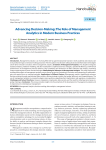
Advancing Decision-Making: The Role of Management Analytics in Modern Business Practices
Статья научная
Introduction. Management analytics is an evolving field that has gained substantial traction in both academia and industry due to its profound impact on decision-making processes. The inte-gration into decision making of advanced information technologies and AI drive innovative solutions within management analytics. Evolution of Management Analytics. The discipline integrates statistical analysis, predictive modeling, and data visualization to optimize business strategies, operational efficiency, and financial performance. As management practices advance, they contribute new dimensions to data collection and analysis, presenting unique opportunities to boost nanotechnologies. Methodological Advances in Management Analytics. This study explores the transformative effects of management analytics across diverse sectors by illustrating its evolution and interpreting its methodologies with special focus on nanotechnologies. Applications in Different Sectors. Management analytics significantly enhances decision-making through sophisticated data analysis, offering strategic insights that propel efficiency and competitiveness. The use of management analytics in nanotechnologies raises questions regarding ethical implications and regulatory considerations. Challenges and Future Directions. However, integration complexities, data security, and the need for skilled personnel pose ongoing challenges. Conclusion. This review provides insights into the potentials of the development of management analytics and its importance in contemporary management.
Бесплатно
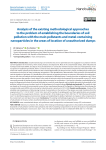
Статья научная
Introduction. Unauthorized dumps are territories that are not permitted and not equipped in accordance with the current legislation of the territory, where waste products are disposed of. Most of the unauthorized dumps, both industrial and municipal solid waste (MSW), are objects of accumulated harm. In connection with the increase in the use of nanoparticles of various genesis in engineering materials, there is a need to assess their impact on environmental components and human health. One of the main marker substances that determine the ecotoxicological effect of dumps are heavy metals, including those entering the environment in the form of metal-containing nanoparticles. Their identification, determination of the processes of horizontal and vertical migration of pollutants (P), identification of the intensity of negative processes are necessary information for making decisions on the choice of methods and technologies for recultivation of disturbed areas. Currently, there are no legislative acts (LA) that take into account the specifics of such objects in the study of territories within the framework of environmental surveys (ES), which necessarily precede the implementation of project documentation for recultivation. A vital task is to develop a methodological approach to diagnosing the state of territories disturbed as a result of waste disposal, and to reliably determine the boundaries of soil pollution, taking into account modern trends in the development of nanotechnology. Methods and materials. The analytical study was based on the results of environmental surveys at four unauthorized dumps of the Republic of Bashkortostan (three dumps for municipal solid waste (MSW) and one dump for industrial waste), carried out in 2019–2020. Results and discussion. A study of the reliability and completeness of determining the level of soil pollution in the territory of the dumps was made. Deviations from the requirements of СS 11-102-97, GOST 17.4.3.01-83 in terms of the number of sampling points and their spatial location were revealed. It was found that the requirements of Article 1 and Article 80.1 of the Federal Law of 10.01.2001 No.7-FL “On Protection of Environment” on identifying negative environmental changes and establishing the ability of pollutants to migrate to other components of the environment were not taken into account. Conclusions. The existing methodological approaches to establishing the boundaries of soil pollution in the areas where unauthorized dumps are located require revision and specification.
Бесплатно
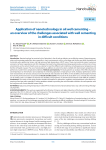
Статья научная
Introduction. Nanotechnology has received a lot of attention in the oil and gas industry as an effective means of improving properties and increasing production rates, especially in harsh environments such as ultra-deep and shallow gas fields, deviated and horizontal wells, geothermal zones, and high pressure/high temperature (HPHT) areas. These environments present numerous economic, technical, operational, and HSE challenges that need to be addressed.Cementing operations play a critical role in these environments, as the cement sheath serves as a barrier to meet the different well conditions, including pressure, temperature, and the flow of liquids or gases. The use of nanomaterials as additives to cement has been credited with improving its properties and performance under these complicated conditions. Methods and materials. The study presents an analysis of the effect of pressure and temperature on the behavior and complexity of cementing operations in high-pressure wells. Analytical performance of the main characteristics of nanoclay (structural and mechanical) and evaluation of its effect on the durability and strength of cement slurry during well construction are presented. Results and Discussion. The results of the study allow us to conclude that nanoclay can be widely used as an additive to improve the durability and properties of cement-based materials under difficult conditions. Conclusions. The results of this study provide valuable information to researchers, engineers and practitioners in the field of cementing oil and gas wells, especially in solving problems related to providing the most favorable conditions for well operation with the long-term use of more durable cement slurry.
Бесплатно
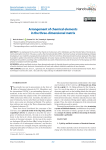
Arrangement of chemical elements in the three-dimensional matrix
Статья научная
It is emphasized in the article that thanks to the discovery of D.I. Mendeleev and the Periodic Table of chemical elements existing for more than 150 years, as well as the international table IUPAC, chemistry has been actively developing and keeps developing. A new model for arranging chemical elements in the form of a three-dimensional matrix has been proposed. This makes it possible to predict new elements with the designation of nuclear masses and the electronic structure of shells. There have been developed new patterns according to the cyclicity (block structure) of horizontal rows and the structure of vertical groups and their physical conception have been specified.
Бесплатно
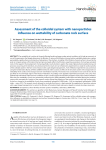
Статья научная
The wettability of a surface of channels filtering liquids and gases under natural conditions of oil and gas reservoirs is one of the parameters that largely determines the filtration. A nature of the filtration channel surface wettability determines a phase permeability, capillary forces and intensity of adsorption at the interface. An ability of the filtration channel surface to be wet by the polar or nonpolar phases of formation fluid and process liquids affects the filtration-capacitive parameters of oil and gas saturated rocks. In this regard, in the development of oil and gas fields, much attention is paid to the study of physicochemical phenomena and processes occurring at the interfaces. An article presents the results of a set of laboratory experiments to study the surface activity of the colloidal system in the form of an emulsion with supercharged nanoparticles. A set of filtration experiments was carried out using the United States Bureau of Mines (USBM) method in order to assess an effect of the emulsion system with nanoparticles on wettability of the surface of oil and gas reservoir rock filtration channels. The research was conducted on rock cores of two oil and gas fields in the Ural-Volga region of the Russian Federation. According to the applied experimental procedure, rock cores were preliminarily maintained under reservoir conditions to give a surface of pore channels the properties close to the natural conditions. After that, the wettability of rocks was assessed by measuring the USBM wettability index before and after filtering the emulsion system with nanoparticles. Analysis of the research results showed that filtration of the emulsion system with high surface activity led to a change in the wettability of rocks from completely hydrophilic (USBM index – 0.60) to completely hydrophobic (USBM index – minus 0.32). The research results allowed to conclude that there is a high potential for application of emulsion systems with supercharged nanoparticles to control the filtration of formation fluids and process liquids in natural oil and gas reservoirs.
Бесплатно
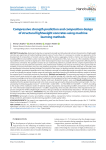
Статья научная
Introduction. Reducing the density, increasing the strength and other physical-technical characteristics of lightweight concretes are urgent tasks of modern building materials science. To solve them, it is necessary to consider new approaches to the development of compositions of cement systems using effective porous aggregates, binders, chemical and mineral additives, including different nanomodifiers (carbon nanotubes, fullerenes, nanoparticles of SiO2, Al2O3, Fe2O3, etc.). The complexity of designing modified cement concretes is largely due to their multicomponent nature and a large number of parameters affecting the key characteristics of material. The qualitative solution of such multicriteria problems is possible with the complex implementation of rational physical and computational experiments using mathematical modeling and computer technology. New opportunities for modeling of structure formation processes and predicting properties of multicomponent building materials are emerging with the development of machine learning methods. The purpose of this study is to develop machine learning algorithms that can efficiently establish quantitative dependences for the compressive strength of modified lightweight concretes on their composition, as well as to identify the optimal variation ranges of prescription parameters based on the obtained multifactor models to achieve the required level of controlled mechanical characteristic. Methods and materials. The processing and analysis of experimental research results were carried out using modern methods of machine learning with a teacher used in the problems of regression recovery, knowledge extraction and forecasting. To implement the developed machine learning algorithms, libraries in the Python programming language, in particular NumPy, Pandas, Scikit-learn, Matplotlib, Seaborn, were used. Results and discussion. It is established that the gradient boosting model is the most accurate type among the obtained machine learning models. It is characterized by the following quality metrics: R2 = 0.9557; MAE = 2.4847; MSE = 12.7704; RMSE=3.5736; MAPE = 11.1813%. According to the analysis of this multifactor model, the optimal dosages of pozzolanic and expanding modifiers amounted to 4.5–6.0% and 6.0–7.5% of the binder weight (Portland cement + modifier), respectively, which ensured achievement of the required level of compressive strength (40–70 MPa) of lightweight concretes at the age of 28 days at material density reduced by 3–10% (the range under consideration is 1200–1900 kg/m3). Conclusions. Thus, the study results show the prospects of using machine learning methods for design compositions and predicting properties of multicomponent cement systems.
Бесплатно
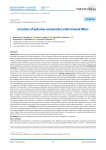
Creation of polymer composites with mineral fillers
Статья научная
Introduction. Currently, the development of science and technology requires the creation of new polymer composites with high technical characteristics for various industries. One of the primary methods to improve the physical and technical characteristics of polymer composites based on thermoplastic elastomers is by incorporation of natural fillers. In the Kyrgyz Republic, there is particular interest in using fine mineral fillers extracted from local natural resources. The minerals and rocks found in the region are characterized by high availability, extensive reserves, and a variety of properties. The accumulated experience in research and practical application opens up prospects for using these materials to create polymer composites with unique characteristics. This opens up new possibilities for using the cavitation process in various industrial applications, including the grinding of materials. Methods and materials. An experimental hydrocavitation mill has been developed to produce fine powders from minerals and rocks intended for use as fillers in polymer composites. The physicochemical properties of polymer composites and their raw materials were studied using modern instruments and equipment. The fractional composition and physical and technical characteristics of some minerals and rocks used to obtain active fillers for polymer composites are given. Results and Discussion. The fractional composition of crushed fillers with a particle size of less than 0.31 mm is distributed as follows: finely ground basalt – 7.3%, wollastonite – 44.6%, marble dust – 50.26%, brown coal powder – 47.56%. The analysis shows that among the studied fillers, finely ground basalt contains the smallest amount of fine fractions, which is due to its high hardness compared to other minerals such as wollastonite, marble, and coal. Physical and mechanical studies of the resulting polymer composites showed that when finely ground basalt is added, an uneven distribution of basalt powder in the polymer matrix is observed, which leads to a decrease in the strength characteristics of the composite. Therefore, to obtain a more durable material, it is necessary to grind minerals and rocks to the level of microparticles using the cavitation effect. For this purpose, a laboratory mill was created that operates based on the cavitation effect. Fillers at the level of micro- and nanoparticles were obtained using the developed hydro cavitation mill. The physical and technical characteristics of polymer composites with additives of the resulting nanofillers have been determined. The compressive strength of composites with mineral fillers (fraction less than 0.31 mm, content of wollastonite filler in the composite – 25.2%) was 5.47 MPa, with basalt filler – 5.2 MPa, and with leather powder (dust) – 4.25 MPa. Fillers at the level of micro- and nanoparticles were obtained using the developed hydro cavitation mill. The physical and technical characteristics of polymer composites with additives of the resulting nanofillers have been determined. The compressive strength of composites with mineral fillers (fraction less than 0.31 mm, content of wollastonite filler in the composite – 25.2%) was 5.47 MPa, with basalt filler – 5.2 MPa, and with leather powder (dust) – 4.25 MPa. The compressive strength of the composite with the addition of carbon filler (13.2%) was 4.2 MPa. The introduction of up to 14.2% of mineral fillers into the composition of the composite increases its heat resistance: when adding basalt filler – up to 106 °C, and wollastonite – up to 114 °C. Conclusion. The fractional composition of mineral fillers based on inorganic raw materials studied for their use in creating polymer composites. A hydro cavitation mill was made and a method for processing fillers from minerals and rocks was developed. New polymer composites were obtained with the addition of basalt, wollastonite, marble, and leather industry waste. Studies have been carried out on the physical and technical characteristics of these polymer composites depending on the content of fillers, such as basalt, wollastonite, marble and leather industry waste.
Бесплатно
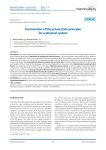
Development of the actual state principle for a physical system
Статья научная
Introduction. The article briefly discusses the state of scientific research in the field of mathematical modeling of physical systems with distributed parameters. Mathematical modeling in elasticity theory. The initial boundary value problem of linear elasticity theory is formulated. It is shown that using measured and unmeasured variables, it is possible to construct a positive definite energy relationship, which allows not only to use the variational technique to find an approximate solution, but also to design objective estimates of its quality. Two-dimensional problem of elasticity theory (static case). Using the example of solving a two-dimensional static problem of linear elasticity, the advantages of the proposed approach are discussed in detail. Mathematical modeling in fluid theory. The variational principle in fluid theory is formulated. Optimal pressure control. Using the example of solving the problem of the motion control for ideal and viscous fluids in pipeline systems, the issues of finding an approximate solution and estimating its accuracy are discussed. Energy principle in the heat transfer problem. The variational principle in the linear heat transfer problem is formulated. Two-dimensional heat transfer problem. The features of constructing a solution to a control problem in a two-dimensional heat transfer theory are discussed in detail. Generalizing principle. A generalizing principle of the actual state of a physical system is formulated, which can be effectively applied for a detailed description and analysis of physical processes.
Бесплатно
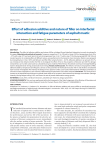
Статья научная
Introduction. The effect of adhesion additive and nature of filler on fatigue life and interfacial interaction in mastic is analyzed in this paper. Materials and methods of research. Frequency sweep from 0.1 to 100 rad/s at strain 0.05% at temperatures from 30 to –10°С with a step 10°С and cyclic tests (LAS test) at temperatures from 16 to 1°С with a step 3°С for bitumen grade BND 100/130 and mastics based on it, containing fillers of different nature, were performed on the dynamic shear rheometer. Mastics were prepared by mixing bitumen (3 min; 160°С and 600 rpm) and filler (filler volume fraction – 0.275). Adhesion additive in an amount of 0.7%, was introduced into bitumen before the filler to investigate the effect of AD on the properties of bitumen and AB. The damage characteristic curve under cyclic loads was calculated using two models of VECD theory (Viscoelastic Continuum Damage Modeling System): dissipated strain energy and pseudo-strain energy. Results and Discussion. The influence of nature and properties of filler, adhesive additive, temperature and frequency of tests on the parameter of interfacial interaction K-B-G* and thickness of adsorbed layer has been investigated. The intensity of damage in the specimen under cyclic loads and the behavior of fatigue parameters as a function of test temperature at two variants of determining the parameter α have been analyzed. Conclusion. It is shown that an increase in the interfacial layer thickness in asphalt mastic leads to an increase in their resistance to damage accumulation (Damage Intensity) during fatigue testing (LAS), and lowers the rate of pseudo-deformation energy growth.
Бесплатно
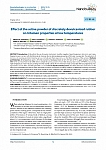
Статья научная
Introduction. In the article the use of powder elastomeric modifier capable of rapid breakdown into micro- and nanofragments upon contact with hot bitumen to improve the low-temperature properties of bitumen is presented. The indicators of resistance to cracking are determined by various methods and their dependence on the thermal history of the samples. Methods and Materials. At temperatures up to –36оC the oscillatory rheological tests (4-mm DSR test) of RTFO-aged samples of bitumen BND 60/90 and modified binder (MB) which contain the active powder of discretely devulcanized rubber (APDDR) produced by high-temperature shear-induced grinding from the crumb rubber of worn tires have been conducted. MB was prepared by mixing bitumen (3 min; 160оC and 600 rpm) with 12.5 wt.% APDDR. Results and Discussion. The effect of the test parameters on the rheological parameters has been studied. Structural transitions in bitumen and MB by methods of differential scanning calorimetry (DSC) and the cracking temperature of the same samples in static conditions in the ABCD test were detected. It is revealed: a decrease in the temperature of actual cracking of the MB sample compared to bitumen. Conclusion. It is shown that APDDR as a modifier affects the structure of bitumen and reduces the temperature sensitivity of bitumen to external influences.
Бесплатно
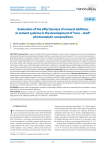
Статья научная
Introduction. Creation of highly efficient photocatalysts for construction composites, which are characterized by increased activity and an extended spectral range of action, is a very important area of research. It is known that “core (substrate) – shell (photocatalyst)” compositions, where mineral raw materials of various genesis can act as carriers, are one of the most effective types of photocatalytic additives for cement systems. It is worth noting that for integrated assessment of the substrate efficiency, we need to obtain information on the composition and properties of raw materials used among which its chemical activity and structure-forming role in cement systems are of paramount importance. The purposes of this study are (1) to establish the influence pattern of four types of mineral additives (silica fume, metakaolin, expanding sulfoaluminate modifier and microcalcite) on the structure formation processes of plasticized cement systems and (2) to identify the most effective modifiers for further use as mineral substrates in the photocatalytic compositions. Methods and materials. Specific surface area and granulometric composition of mineral modifiers were determined by the Kozeny-Karman and laser diffraction methods. The phase composition of mineral additives and modified cement systems were studied using X-ray diffraction phase analysis. Results and discussion. Features of mineralogical and granulometric compositions of mineral additives were revealed. It was determined that the use of individual and complex mineral additives based on silica fume, metakaolin and ESAM made it possible to directionally influence on content of the main phases of cement stone such as ettringite, portlandite, calcium hydrosilicates of different basicity. Conclusions. The increased chemical activity of these modifiers in cement systems, due to presence of reactive minerals in the structure, along with features of the granulometric composition (high dispersity and narrow particle size distribution), indicated the potential prospects for their use as mineral substrate in “core – shell” photocatalytic compositions.
Бесплатно
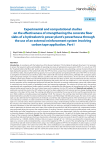
Статья научная
Introduction. In accordance with the Federal Law of the Russian Federation ”On the Safety of Hydraulic Structures“, it is necessary to ensure the long-term safety and reliability of operating structures at hydroelectric power plants (HPPs). In a run-of-river HPP, the "headwall-turbine hall floor slab" system serves as the main load-bearing structure, absorbing a variety of external forces and loads during the operation of the turbine hall within the HPP. Over time, surveys have revealed the intensive cracking in reinforced concrete floor slabs, reducing their bearing capacity. To ensure safe operation and prolong the life cycle of the HPP, it is necessary to strengthen the reinforced concrete floor slabs of the turbine hall with external reinforcement, preferably with composite carbon tapes having high strength, low weight, dielectric qualities and other positive characteristics. At the same time, the method of installing carbon tapes should ensure that finely dispersed conductive dust does not form, since the reinforced concrete structures of the HPP turbine hall, saturated with electrical equipment that powers the HPP, are reinforced. It is also necessary to ensure that the operation of the strengthened reinforced concrete floor slab with an external reinforcement system with carbon tapes is monitored over time by means of embedded control and measuring equipment. The solution of the tasks set in the present experimental and computational studies made it possible to substantiate the effectiveness of strengthening the floor slab with external reinforcement based on the use of carbon tapes and to implement it in the HPP turbine hall. Materials and methods. The reinforced concrete floor slab in the HPP turbine hall, which has been subjected to both external and non-design loading during operation, is the object of this study. The cracking and deflections recorded by the surveys led to the need for experimental studies in field conditions, including using a load weighing 150 kN. The stresses in the working metal stretched reinforcement were determined before and after the external reinforcement device with FibArmTape-530/300 carbon tapes. The stress in the carbon tapes was also determined. The experiments of reinforced concrete floor slab models’ fragments of the stretched zone were carried out in laboratory conditions in order to determine the effectiveness of the reinforcement using a new method of installing carbon tapes on a concrete surface. These experiments were carried out using a tensile breaking machine and confirmed the positive effect of using a new method of carbon tape device, preventing the formation of finely dispersed conductive dust in the operating electrical installations of the HPP turbine halls. At the same time, the necessary strength of reinforced structures is obtained. In order to determine the formed stress-strain state of the reinforced concrete floor slab of the turbine hall, computational studies were performed taking into account the revealed nature of cracking. Stresses in stretched working reinforcement under various loads before and after strengthening, as well as stresses in carbon tapes, were determined. Using the calculations performed, a schematic diagram of reinforced concrete floor slab strengthening is proposed – the pitch of the carbon tapes and the number of layers of the composite material. Results. From the results of the experimental studies of models fragments of the reinforced concrete floor slab stretched zone that have characteristics of hydraulic structures (concrete of class B15 and B25, low coefficient of reinforcement μs = 0.00445÷0.00692, it follows that an increase in strength of 1.62–1.96 times was obtained for composite carbon tapes on a concrete surface strengthened by a new method (applied to HPP). As a result of the strengthening of the reinforced concrete floor slab with external reinforcement using a new method (applied to HPP) for the installation of carbon tapes, as a result of experimental studies in the turbine hall of the HPP, a stress redistribution was established between metal working reinforcement and carbon tapes, which were included in joint work with the floor slab with the formation of tensile stresses in the tapes. Under loading on a reinforced floor slab with 150 kN, the tensile stresses in the metal reinforcement decreased by 1.8–2.9 times (directions – along the flow and across the flow) with the formation of almost equivalent stresses in carbon tapes of the external reinforcement. In order to calculate the changes in the stress-strain state of the floor slab of the turbine hall of the HPP building (with cracking, with support that is not designed in some places under the influence of non-designed loads) strengthening with external reinforcement with carbon tapes, a spatial finite element model was developed and applied.
Бесплатно

Статья научная
Introduction. In accordance with the Federal Law of the Russian Federation “On the Safety of Hydraulic Structures”, it is necessary to ensure the long-term safety and reliability of operating structures at hydroelectric power plants (HPP). In a run-of-river HPP, the “headwall-turbine hall floor slab” system serves as the main load-bearing structure, absorbing a variety of external forces and loads during the operation of the turbine hall within the HPP. Over time, surveys have revealed the intensive cracking in reinforced concrete floor slabs, reducing their bearing capacity. To ensure safe operation and prolong the life cycle of the HPP, it is necessary to strengthen the reinforced concrete floor slabs of the turbine hall with external reinforcement, preferably with composite carbon tapes having high strength, low weight, dielectric qualities and other positive characteristics. At the same time, the method of installing carbon tapes should ensure that finely dispersed conductive dust does not form, since the reinforced concrete structures of the HPP turbine hall, saturated with electrical equipment that powers the HPP, are reinforced. It is also necessary to ensure that the operation of the strengthened reinforced concrete floor slab with an external reinforcement system with carbon tapes is monitored over time by means of embedded control and measuring equipment. The solution of the tasks set in the present experimental and computational studies made it possible to substantiate the effectiveness of strengthening the floor slab with external reinforcement based on the use of carbon tapes and to implement it in the HPP turbine hall. Materials and methods. The reinforced concrete floor slab in the HPP turbine hall, which has been subjected to both external and non-design loading during operation, is the object of this study. The cracking and deflections recorded by the surveys led to the need for experimental studies in field conditions, including using a load weighing 150 kN. The stresses in the working metal stretched reinforcement were determined before and after the external reinforcement device with FibArmTape-530/300 carbon tapes. The stress in the carbon tapes was also determined. The experiments of reinforced concrete floor slab models’ fragments of the stretched zone were carried out in laboratory conditions in order to determine the effectiveness of the reinforcement using a new method of installing carbon tapes on a concrete surface. These experiments were carried out using a tensile breaking machine and confirmed the positive effect of using a new method of carbon tape device, preventing the formation of finely dispersed conductive dust in the operating electrical installations of the HPP turbine halls. At the same time, the necessary strength of reinforced structures is obtained. In order to determine the formed stress-strain state of the reinforced concrete floor slab of the turbine hall, computational studies were performed taking into account the revealed nature of cracking. Stresses in stretched working reinforcement under various loads before and after strengthening, as well as stresses in carbon tapes, were determined. Using the calculations performed, a schematic diagram of reinforced concrete floor slab strengthening is proposed – the pitch of the carbon tapes and the number of layers of the composite material. Results. From the results of the experimental studies of models fragments of the reinforced concrete floor slab stretched zone that have characteristics of hydraulic structures (concrete of class B15 and B25, low coefficient of reinforcement μs = 0.00445÷0.00692, it follows that an increase in strength of 1.62–1.96 times was obtained for composite carbon tapes on a concrete surface strengthened by a new method (applied to HPP). As a result of the strengthening of the reinforced concrete floor slab with external reinforcement using a new method (applied to HPP) for the installation of carbon tapes, as a result of experimental studies in the turbine hall of the HPP, a stress redistribution was established between metal working reinforcement and carbon tapes, which were included in joint work with the floor slab with the formation of tensile stresses in the tapes. Under loading on a reinforced floor slab with 150 kN, the tensile stresses in the metal reinforcement decreased by 1.8–2.9 times (directions – along the flow and across the flow) with the formation of almost equivalent stresses in carbon tapes of the external reinforcement. In order to calculate the changes in the stress-strain state of the floor slab of the turbine hall of the HPP building (with cracking, with support that is not designed in some places under the influence of non-designed loads) strengthening with external reinforcement with carbon tapes, a spatial finite element model was developed and applied.
Бесплатно
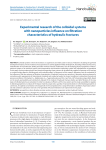
Статья научная
Colloidal systems in form of emulsions or suspensions are widely used in various of industries including oil-gas fields development industry. Invert emulsions and suspensions are actively applied in fields development, including enhanced oil recovery, intensification of oil production, drilling and wells workover. Results of laboratory tests for studying physical properties of heterogeneous systems as an emulsion system with nanoparticles and emulsion-suspension system with nanoparticles are presented in this paper. Having unique physical and chemical properties these systems can be effectively applied in upstream of oil and gas as a water-limiting agent or blocking pack with reversible effect. In framework of this research, laboratory tests for evaluation of the influence of the new systems on filtration characteristics of hydraulic fractures are carried out. Laboratory tests are planned in accordance with requirements of international standards and conducted under the closest conditions to subsurface thermal and pressure conditions of formations STyr Abdylovskoe, SBASh Yugomashevskoe and YuS-2 and YuS-4 of Tortasinskoe oil-gas fields. Based on the results, permeability and conductivity indexes of the models of hydraulic fractures before and after filtration of the new types of colloidal systems are calculated. In order to evaluate an efficiency of the new systems and to study a possibility to regulate its blocking properties an analysis of the impact made by a type and a quantity of nanosized solids on to the blocking properties is carried out. An optimal concentration of nanoparticles in the compositions for a range of formation conditions of particular carbonate and sandstone subsurface reservoirs of oil-gas fields of Russian Federation are represented in this paper.
Бесплатно
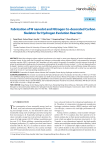
Fabrication of W nanodot and Nitrogen Co-decorated Carbon Skeleton for Hydrogen Evolution Reaction
Статья научная
Metal dots-nitrogen-carbon catalysts have become a hot topic in recent years because of special coordination environment. Herein, for the study the W nanodots and nitrogen co-decorated carbon skeleton (W@NC) was prepared for hydrogen evolution reaction (HER). In particular, NaCl templates not only restrict the growth of nanodots, but also improve the purity of phase. By optimizing the feeding ratio of ammonium metatungstate, W nanodots (the size is about 1.2 ± 0.6 nm) dispersed well on N-doped C skeleton, and this special structure could effectively promote electron transfer and ion diffusion during HER process. As a result, the optimized W@NC hybrids exhibited excellent HER performance in alkaline media with a rather low over-potential (228 mV at 10 mA cm–2) and outstanding durability over 10 h.
Бесплатно
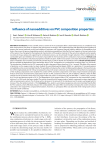
Influence of nanoadditives on PVC composition properties
Статья научная
Introduction. In this scientific article a scheme of the no synergistic effect is observedion process is considered. It has been shown that to slow down or suppress the main process occurring in the condensed phase and determining the formation of gaseous fuel several methods can be used: addition of polymers with increased thermal stability; addition of nanoadditives that reduce the amount of gaseous degradation products; introducing nanoadditives that affect the heat capacity or thermal conductivity of the system, thus changing the thermophysical characteristics of the polymer material. At the same time reduced reaction speeds, occurring in the gas phase and supporting the combustion process, can be achieved through reduction of the concentration of combustible gases and inhibition of the reactions responsible for the branching of the combustion chain process. Methods and materials. The composition and physical properties of kaolin are given. Kaolin monocrystal is a two-layer aluminosilicate containing water of hydration and consisting of chemically bonded layers of silicon dioxide and hydrated alumina. Results and discussion. We have studied the dependence of the attenuation time of a PVC composition on a composition containing from 3 to 10% kaolin. The introduction of kaolin into the PVC compound has led to decrease of decay time from 4.5 to 1 seconds. The effect of the amount of plasticizer on the oxygen index has been studied. We used dibutoxyethyl adipate (DBEA) as a plasticizer. It has good polymer compatibility and is environmentally friendly. The possibility of reducing the content of dibutoxyethyl adipate in the basic formulation of the original plasticate I40-13A by increasing the amount of calcium carbonate was studied, then the performance properties of the resulting compositions were studied. The content of PVC and other components in the basic recipe remained unchanged. Analysis of the data showed that for plasticization of 62% wt PVC contained in I40-13A, 20% wt DBEA is sufficient, while the filler content can be increased at least twice. The oxygen index (OI) value at a component ratio of 20% DBEA + 13.56% CaCO3 increases by 4 OI units and becomes equal to 29.1%. The dependence of the oxygen index of PVC compound on the composition containing from 5 to 20% kaolin has been studied. The results showed that the oxygen index of plastic compound increases significantly with increasing kaolin content. The OI drops with a decrease in the amount of the introduced, and it remains unchanged with its increase. Thus, the optimal content is 15%. Conclusion. Thus, kaolin is a promising, inexpensive and environmentally friendly filler for PVC materials, which effectively reduces their combustibility. The same effect is achieved by increasing the content of calcium carbonate in the original PVC compound formulation. However, no synergistic effect was observed while mixing kaolin and an excess of calcium carbonate.
Бесплатно
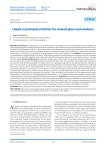
Liquid crystaloptical shutter for stained glass and windows
Статья научная
Introduction. Liquid crystal as a nanomaterial has found application in science, engineering and technologies. The unique physical properties of liquid crystals make them sensitive to external influences. The article presents the results of an experimental study of the flexoelectric effect in a liquid crystal, when shear deformations occur, thin layers of which can serve as an optical shutter for the stained glass windows of buildings. Materials and methods. Nematic liquid crystals with a homeotropic orientation of molecules 10÷100 μm thick were used by the birefringence method. Shear frequency 1 kHz. Methods. The experimental cell was assembled from two glass plates in the form of a flat capacitor, spacers were placed between the glasses, which set the sample thickness. A source of shear vibrations was located on the side of the microscope stage, which was connected to the LC cell using a thin waveguide. Results and discussion. According to the geometry of the problem, the director is headed vertically parallel to the Z axis, the velocity vector of the plate vibrations is horizontal along the X axis. The orientation of the liquid crystal molecules in the volume is characterized by the angle θ. An elastic-viscous wave propagates between the moving and stationary substrates of the LC cell, which leads to a perturbation of the initial homeotropic orientation of the director field. The dependences of the first and second harmonics of the shear-induced EMF, as well as the optical signal, on the plate oscillation speed are obtained. They have a threshold nature of occurrence at a critical speed υc~8 mm/s, while the liquid crystal molecules are oriented at an angle θс. The temperature dependences of EMF harmonics far from the nematic – isotropic liquid phase transition showed that when approaching the phase transition, the regression of the signal U1ω stops, and then its value increases up to the temperature transition of the nematic – isotropic state TNI. The magnitude of the optical signal I2ω/Io(T), approaching the phase transition, increases, which is explained by the increase in the amplitude of the director oscillation Θd. Conclusion. The article considers the flexoelectric effect observed in thin layers of nematic liquid crystals with homeotropic orientation of molecules placed between two glass plates. The occurrence of the effect has a threshold character, the critical strain rate is about 8 mm/s. The conditions and parameters of the effect (shear amplitude, sample temperature) on a condenser cell for various liquid crystals are considered. It is proposed to use the results obtained to create an optical shutter (shutter) for stained glass windows or windows of buildings and structures.
Бесплатно
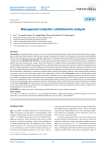
Management Analytics: A Bibliometric Analysis
Статья научная
Introduction. As nanotechnology continues to evolve and its industrial applications expand, the need for effective data management, analysis, and dissemination is becoming more urgent. Management analytics has emerged as a critical new interdisciplinary field in current business environments, enabling organizations to leverage data-driven insights for informed decision-making and strategic planning. Methods and materials. This study reviews and analyzes research in the interdisciplinary field of management analytics for the period from 2021 to 2023. To conduct bibliometric analysis, data from various sources were used, including academic publications, monographs, reviews, reports, etc. Through a systematic review of the relevant literature, this study aims to provide insight into key topics, methodologies and outcomes in the field of management analytics, as well as to identify directions for future research directions. Results: according to the results of the analysis, it was found that the main source of articles in this area is the Journal of Management Analytics. The total number of publications on this topic for the period amounted to 83 units, the total number of citations for a certain time period has been increasing. The leading countries in terms of the number of citations of academic articles on the topic under study are the United States, India and China. Discussion. So far, the interdisciplinary field of management analytics has not been widely discussed in academic circles. However, leading countries in the world in terms of the number of academic articles and citations are at the forefront of this emerging field. This should be taken into account especially in the development of the nanosystems and nanomaterials industry, which is one of the priority areas for the development of science and technology, where management analytics technologies will be in demand and can provide competitive advantages to companies. Conclusion. The importance of the new interdisciplinary field of management analytics will continue to grow. In the course of the study, it was found that this emerging field has been increasing its popularity and it could be an effective tool for organizations in the nearest fu-ture.
Бесплатно

